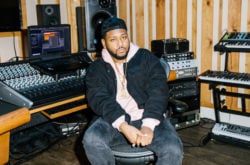Charles Burchell, also known as BLVK Samurai, is a producer, composer, multi-instrumentalist, and educator.
He recently released a Splice Originals sample pack that he produced with his group The Love Experiment. He’s also the instructor of Soundfly’s new online course, “The Art of Hip-Hop Production,” which you can get a 20% discount on by using the promo code SpliceHIPHOP.
In this blog post, Charles Burchell offers his five tips on producing hip hop.
I’ve been working as a producer for the past ten years, and over the course of that time I’ve taught hip hop production all around the world in various contexts. One of the most frequent questions I get asked is, “How do you become successful as a producer?” The answer is simple in theory, but difficult in execution.
If you want to be a successful producer, you have to work on music everyday and master your workflow, which will enable you to create more music faster and make a positive impact on your career. Here are five tips that, to me, are essential for hip hop producers.
1. Hip hop producers need a lot of tracks, so sometimes finished is better than perfect.
How many beats have you finished this week? This month? This year? The more beats you finish, the more you’ll be prepared when you meet the artist of your dreams and they say, “Send me some beats.” I’ve heard tons of stories of producers showing up to sessions with 600 beats or sending an artist a beat tape of 40+ beats. Your beats are your product. It’s your job to have enough inventory ready to sell, once there’s a demand for your product.
So what’s the best way to stock up your inventory with dope beats? Two things:
- Set a weekly quota. Kanye West famously said he made five beats a day for three summers. While that would be amazing, ten beats a week might be more realistic. At that rate, you can make 40 beats a month and decide which ones you want to sell, save, or send to artists. If you need help with this quota, get a friend or collaborator to hold you accountable. If you join Soundfly’s hip hop production course, you’ll receive six weeks of mentorship to keep track of your progress and hone your sound.
- Think arrangement first. If you organize your sessions with arrangement markers for the intro, verse, chorus, etc., you can start creating loops and copying them into these different sections. This allows you to take a simple four bar loop and expand it into song form by simply copying and pasting, and then adding or subtracting elements from each section to make the different parts of the production stand out.
Don’t forget that quality is more important than quantity, so as you work on creating and finishing more beats, it’s important to put all of your creative facilities into every track you produce. Ten bangers is better than a thousand beats that sound like trash. However, you’ll find that the practice of creating and completing more music consistently in itself will eventually improve the quality of your work.
2. When you’re making a lot of beats, it’s critical to stay organized.
When you’re making as many as ten beats per week, it’s important to title them in a way that makes them easy to find. How many beats on your computer are saved with names like “dsfhsdjfsdk,” “dope beat 1,” or “fizzle sauce?” Try using a description consisting of the beat plus the date (ex. “wavy trap 2.22.19”) instead. This will make it easier to find sessions until they actually become songs with proper titles.
At the end of every month, you can make a folder for all of the beats that you made that month. You can organize your sessions by month (ex. “March Beats 2019”), or even into categories based on genre (e.g. boom bap, trap, pop, etc.).
Once you have consistent clients, it’s also a good idea to have a folder for each of your clients so that you can easily access their sessions when you’re working together, and add ideas that you think suit that client specifically.
Organization is a producer’s best friend. Keep all of your sample packs and drum kits in clearly labeled folders on your desktop / hard drive, or just use Splice and make repacks of your favorite sounds for easy access. It may sound like a lot of work at first, but you’ll be glad once you’re sitting in a session with your favorite rapper and they ask you to play some beats.
3. Diversify your sound by exploring different genres.
If you’re in a creative rut, try making a track in a style that you’ve never produced before. If you make a lot of boom bap-style beats, make a trap beat or an R&B track to mix things up. Listen to other styles of music regularly. Having the ability to produce in different styles and genres will allow you to work with a wider range of artists.
Some of the greatest hip hop producers are flexible in their ability to take what they do and apply it to any style. When you expand your sonic palette, you never know what new influences might start creeping into your production.
Speaking of expanding your sonic palette, if you’re looking for some interesting sounds to inspire your next track, try checking out my new sample pack with my group, The Love Experiment. The pack features tons of live instruments like horns, strings, keyboards, vocals and drum loops that will help take your track to the next level.
4. Too many producers assume that there’s no value in learning an instrument or music theory (wrong).
I hear a lot of producers brag about not having any musical training or music theory knowledge. This sounds cool in a sound bite, but what they don’t say is that when a production calls for something outside of their skill set, they usually have to call a musician who either knows how to play an instrument and / or understands harmony at some level.
It never hurts your production process to learn how to play an instrument, whether it’s taking up sax, guitar, piano, or even drums. You’ll expand your general knowledge of music by learning how to become proficient at an instrument, and you’ll have a new palette of textures to work with. This can also help you stand out from the crowd. If you want to get started right away with picking up some beginner theory, check out Splice’s cheat codes for reading sheet music or Soundfly’s free online course series, “Theory for Producers.”
5. Learn how to quickly get a decent rough mix.
You could have the hottest track the world has ever heard, but with a bad mix, it just isn’t going to pop as hard and reach people emotionally. Remember that hip hop is typically a minimalist genre – less can be more. Here’s some advice for whipping up a great-sounding rough mix quickly.
- Vocals, kicks, and snares are the most important pieces in a hip hop mix. Keep them front and center.
- A good mix is about balance. Start with the loudest section of your song and make sure that you can hear every element clearly without any one sound overshadowing the others. Pay particular attention to bass frequencies. Getting a clear balance between your kicks, 808s, and basslines is essential if you want your track to knock.
- Leave space for the vocals – don’t over-produce. If you have too many elements going on, the artist won’t have any room to create.
- Try experimenting with filters and EQs to remove unnecessary sonic information that isn’t important to a particular track. You can see the frequency range that a particular instrument takes up with a graphic equalizer, and then you can filter out whatever space is unoccupied. This creates more space in your track and a feeling of clarity for every instrument in general.
In today’s fast-paced music market, artists are recording and releasing more content than ever before, so can’t afford to overthink every track. This is particularly true in hip hop, where many emcees enjoy the raw energy of freestyling to a beat and capturing their performance the moment inspiration hits them. If an artist is excited to work with you, they’ll want to start recording as soon as they feel the vibe, and aren’t going to wait for you to get your snare tuning just right. Honing your workflow and developing the skills to create high-quality work at a faster rate will ensure that your music will make it into the hands of the right artists in no time.
Hip hop has grown into the most popular type of music in the world, but there are still some things that make producing hip hop unique to other genres. In our six week course, we’ll explore how to create beats from the ground-up, the cultural components that make hip hop unique, and the tools you’ll need to both build a better track and kickstart your career. If you’re interested in learning more, you should head over to Soundfly and sign up for our new course “The Art of Hip-Hop Production” and get pro help in making your next mixtape.
April 5, 2019



